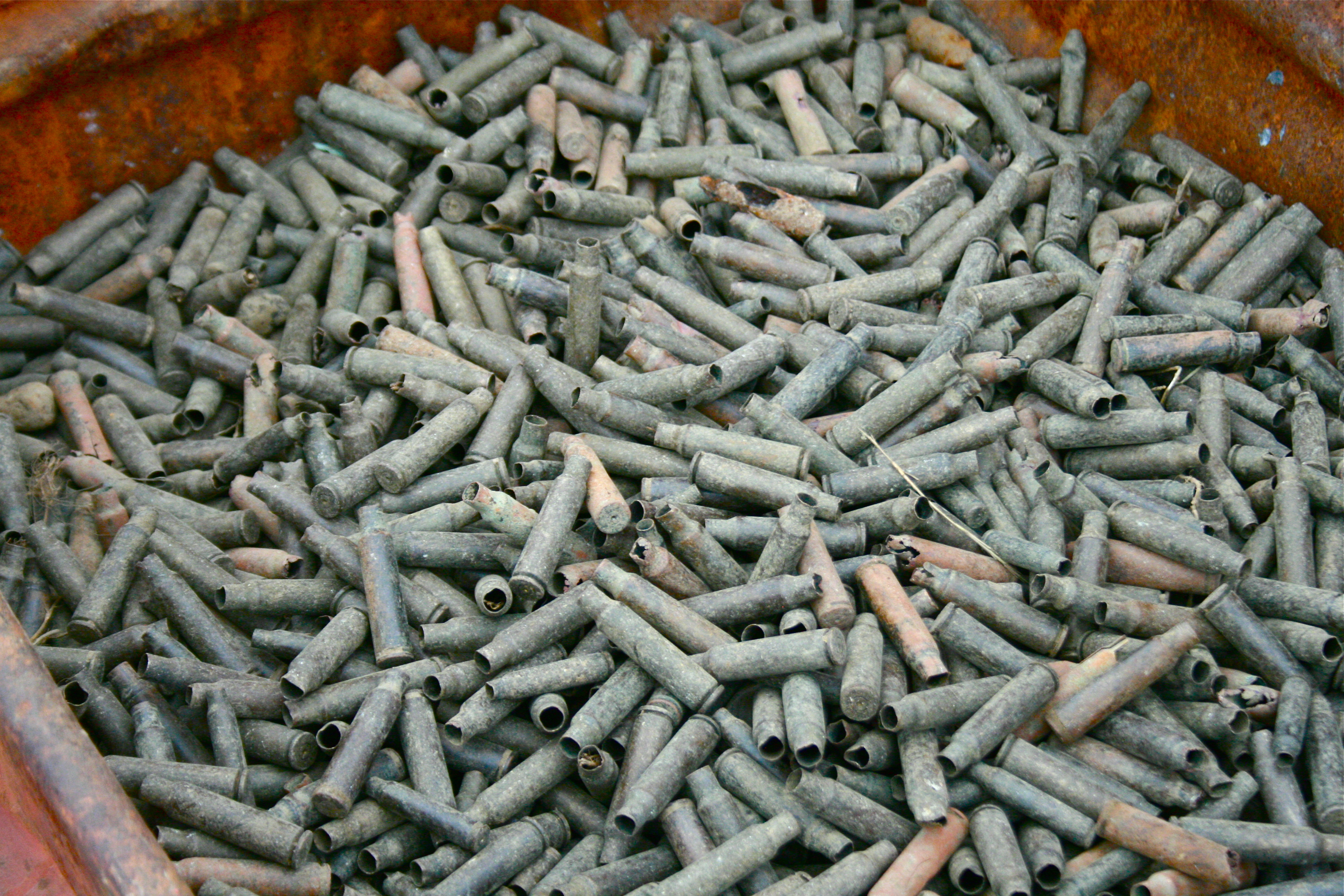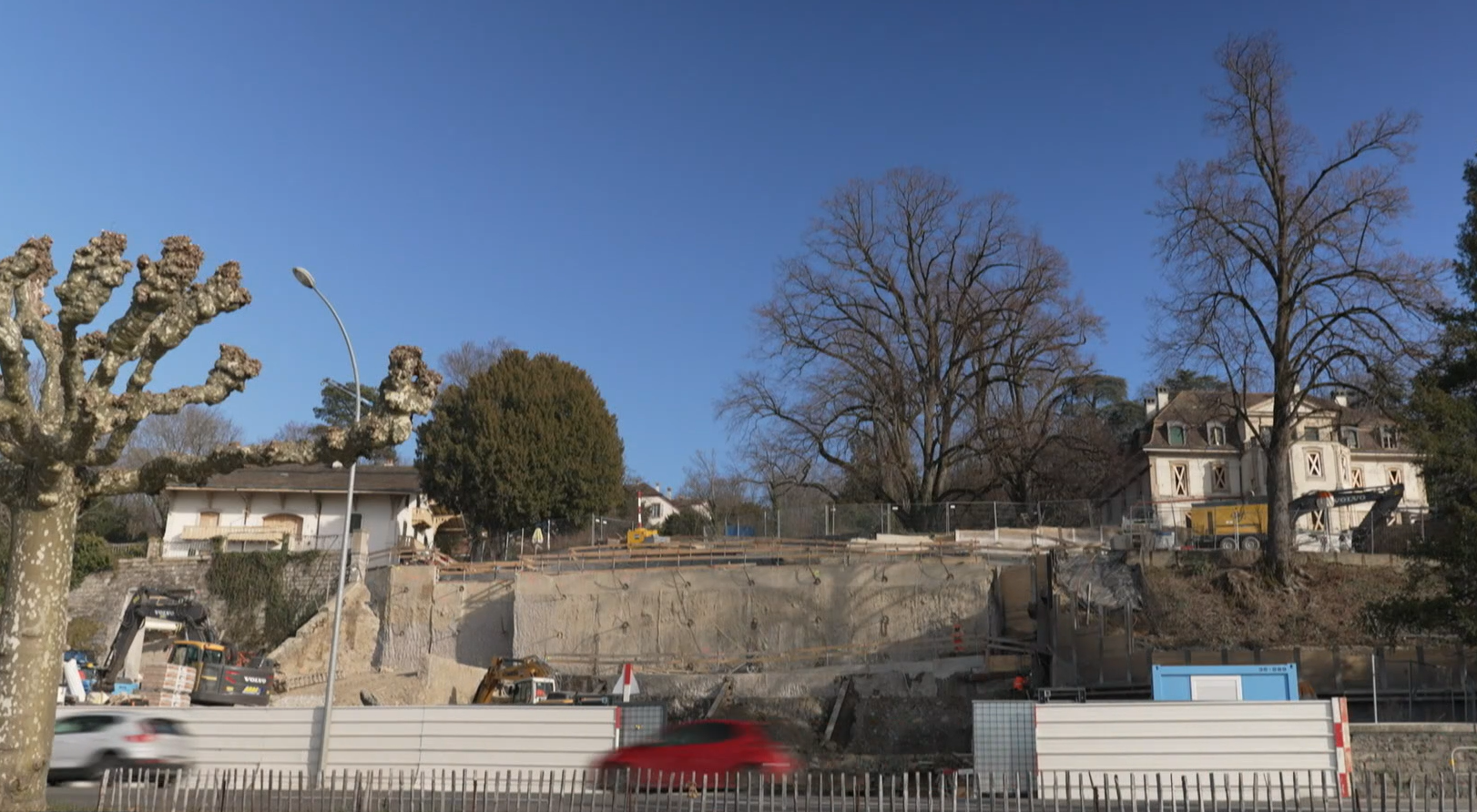Heavy metal cleanup goes off target

Switzerland is earmarking nearly a billion francs to clean up soil contaminated by heavy metals leached from spent bullets.
For a country that has not been to war in its modern history, it comes as a surprise at first to learn that the ground is pumped full of lead – up to 40,000 tons of it.
Manuel Schiffmann takes a baseball-size clump of heavy metal from a large bin. The expert for brownfield site cleanups says it is pure lead, extracted from the earth directly behind a small arms firing range target.
Schiffmann’s company, Marti AG, is hard at work removing, layer by layer, the contaminated soil on the grounds of a former range in Ostermundigen, just outside Bern.
It’s estimated that alone at this 170,000 m² site – which was one of Switzerland’s largest when it was in operation – around 270 tons of lead was fired into the earth in and around the targets, as well as into the forest on the hill high above. A large swathe of trees was cleared to get at it.
“I don’t know why they weren’t better shots,” Schiffmann says, with a hint of gallows humour.
According to the Federal Environment Office, these facilities nationwide are responsible for putting twice as much lead into the environment as the combined output from traffic, industry and business. And unlike the situation in many other nations, most Swiss ranges are or were located in densely populated areas.
Bullet butts
Discussions began in the 1970s on the introduction of new systems of “butts” or “backstops” to prevent the bullets from entering the ground. But it has only been in the last few years that communities and cantons have been under pressure to bite the bullet and take action.
The federal government has promised to cover 40 per cent of the costs of extracting the heavy metals from the soil around the targets. This is mostly lead and antimony – the latter a water-soluble metal that poses a great threat to ground water.
To be eligible for the funds, the local authorities were meant to either put the firing ranges out of service or install environmentally friendly backstops by November 2008.
The clean-up has been estimated at SFr600 million ($584 million) for the 4,000 targets that are no longer in use, and SFr300 million for the 2,000 still in operation.
Moving target
However, parliament approved a motion last year to postpone the deadline to 2012 for the sites where there is a danger the heavy metals may have leached into the groundwater – amounting to ten to 20 per cent of targets – and 2020 for all others.
One of the most vociferous critics of the decision to delay the move is Josef Lang, a Green parliamentarian and high-profile member of the Group for Switzerland without an Army (GsoA).
Lang says that Swiss politicians have always been quick to defend the Swiss militia army system, which requires each man on active duty or in the reserves to do target practice.
Fatherland destroyed
“They are seen as defenders of the fatherland, but as we now realise, they are a threat to the fatherland because they are destroying the land of our fathers,” Lang told swissinfo.ch.
At present, nearly 200,000 men sling their army-issue rifles over their shoulders at least once a year and head out to their local firing ranges.
In the Swiss army’s heyday in the 1980s, there were 700,000 soldiers – an impressive figure in a country of only 6.5 million people at the time.
Most communities maintained their own small ranges with about eight targets, whereas the Oberfeld facility in Ostermundigen had about 300.
According to Mario Andrini, responsible for soil issues in the city of Bern administration, the heavy metals at the site do not pose a threat to the groundwater. Therefore the local authorities were not under pressure to clean it up.
But the city has gone ahead anyway since investors have plans for a large housing development.
Schiffmann takes pains to explain how the removed soil is sorted according to the degree of contamination, and then transported to landfills specially designated to hold such waste.
Stephan Wüthrich of CSD Engineers, the company which lent its expertise to the Ostermundigen project, added: “the lead contamination is between 50 and 85,000mg/kg. Most of the metal will be transported away for recycling.”
Environmental priorities
Although parliament, in its reasoning for the postponement, found that cleaning up the sites was “absolutely necessary”, other unnamed environmental problems were more pressing.
This despite the findings of Geotest, a geological and environmental consultancy that was commissioned to test samples from the soil of four firing ranges in canton Bern.
Geotest engineers said that the groundwater beneath each of the test sites was contaminated.
And they warned that not enough scientific research exists on the behaviour of lead or antimony in the soil.
What is known is that tiny lead particles can become airborne if the contaminated soil is disturbed by wind, or human or animal activity.
Water runoff from storms can also transport heavy metals in the ground away from the confines of a firing range.
The inhalation of lead dust or ingestion of lead-contaminated food can damage the nervous system and cause blood and brain disorders.
Dale Bechtel, swissinfo.ch
According to the Swiss defence ministry, the army will not replace lead bullets with any other kind in the near future.
Spokesman Martin Bühler says only lead bullets meet the precision requirements of rifles used for 300-metre target practice. However, he told swissinfo.ch that the change to a smaller bullet with a 5.6mm bore from one measuring 7.5mm had reduced the lead content by about 60%.
He also points out that other metals used to replace lead in bullets, like copper, also have a negative impact on the environment.
Ruag, a Swiss state-owned technology concern with a large defence unit, has reported that few of Switzerland’s neighbours are confronted with the same problem.
The main concerns of governments on the other side of Switzerland’s borders are clearing the land of explosives and munitions leftover from the two world wars.
And unlike Switzerland, military target practice in European Union countries normally takes place far from inhabited areas. Ruag added that there are few such facilities and nowhere near as much live ammunition is used as in Switzerland.
There is a bigger environmental threat from European hunting clubs. According to Ruag, they often change the locations where they gather to shoot clay pigeons, which means that lead winds up in the soil across wide areas.
To combat this problem, various countries in the EU are considering banning lead or zinc ammunition.

In compliance with the JTI standards
More: SWI swissinfo.ch certified by the Journalism Trust Initiative









You can find an overview of ongoing debates with our journalists here . Please join us!
If you want to start a conversation about a topic raised in this article or want to report factual errors, email us at english@swissinfo.ch.